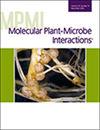求助PDF
{"title":"A Diazeniumdiolate Signal in <i>Pseudomonas syringae</i> Upregulates Virulence Factors and Promotes Survival in Plants.","authors":"Qiang Guo, Caitlin N Vitro, Drake M Crawford, Bo Li","doi":"10.1094/MPMI-06-24-0069-R","DOIUrl":null,"url":null,"abstract":"<p><p><i>Pseudomonas syringae</i> infects a wide variety of crops. The <i>mangotoxin-generating operon</i> (<i>mgo</i>) is conserved across many <i>P. syringae</i> strains and is responsible for producing an extracellular chemical signal, leudiazen. Disruption of the <i>mgoA</i> gene in <i>P. syringae</i> pv. <i>syringae</i> (<i>Pss</i>) UMAF0158 alleviated tomato chlorosis caused by this bacterium. We showed that deletion of the entire <i>mgo</i> reduced <i>Pss</i> UMAF0158 population in tomato leaflets. Leudiazen restored the signaling activity of the deletion mutant at a concentration as low as 10 nM. Both the diazeniumdiolate and isobutyl groups of leudiazen are critical for this potent signaling activity. Transcriptional analysis showed that <i>mgo</i> and leudiazen induce the expression of <i>mangotoxin biosynthetic operon</i> as well as an uncharacterized gene cluster, RS17235-RS17245. We found that this cluster enhances the survival of <i>Pss</i> UMAF0158 in planta and is widely distributed in <i>P. syringae</i> strains. Our results demonstrate that <i>mgo</i> plays prominent roles in the virulence and growth of <i>P. syringae</i>. The <i>mgo</i> and <i>mgo</i>-like signaling systems in different bacteria likely regulate diverse microbe-host interactions. [Formula: see text] Copyright © 2024 The Author(s). This is an open access article distributed under the CC BY 4.0 International license.</p>","PeriodicalId":19009,"journal":{"name":"Molecular Plant-microbe Interactions","volume":" ","pages":"776-783"},"PeriodicalIF":3.4000,"publicationDate":"2024-11-01","publicationTypes":"Journal Article","fieldsOfStudy":null,"isOpenAccess":false,"openAccessPdf":"","citationCount":"0","resultStr":null,"platform":"Semanticscholar","paperid":null,"PeriodicalName":"Molecular Plant-microbe Interactions","FirstCategoryId":"99","ListUrlMain":"https://doi.org/10.1094/MPMI-06-24-0069-R","RegionNum":3,"RegionCategory":"生物学","ArticlePicture":[],"TitleCN":null,"AbstractTextCN":null,"PMCID":null,"EPubDate":"2024/11/27 0:00:00","PubModel":"Epub","JCR":"Q2","JCRName":"BIOCHEMISTRY & MOLECULAR BIOLOGY","Score":null,"Total":0}
引用次数: 0
引用
批量引用
Abstract
Pseudomonas syringae infects a wide variety of crops. The mangotoxin-generating operon (mgo ) is conserved across many P. syringae strains and is responsible for producing an extracellular chemical signal, leudiazen. Disruption of the mgoA gene in P. syringae pv. syringae (Pss ) UMAF0158 alleviated tomato chlorosis caused by this bacterium. We showed that deletion of the entire mgo reduced Pss UMAF0158 population in tomato leaflets. Leudiazen restored the signaling activity of the deletion mutant at a concentration as low as 10 nM. Both the diazeniumdiolate and isobutyl groups of leudiazen are critical for this potent signaling activity. Transcriptional analysis showed that mgo and leudiazen induce the expression of mangotoxin biosynthetic operon as well as an uncharacterized gene cluster, RS17235-RS17245. We found that this cluster enhances the survival of Pss UMAF0158 in planta and is widely distributed in P. syringae strains. Our results demonstrate that mgo plays prominent roles in the virulence and growth of P. syringae . The mgo and mgo -like signaling systems in different bacteria likely regulate diverse microbe-host interactions. [Formula: see text] Copyright © 2024 The Author(s). This is an open access article distributed under the CC BY 4.0 International license.
鞘氨醇假单胞菌(Pseudomonas syringae)中的重氮二酸酯信号可上调毒力因子并促进植物存活。
丁香假单胞菌感染多种作物。产生芒毒素的操作子(mgo)在许多 P. syringae 菌株中都是保守的,它负责产生一种细胞外化学信号--leudiazen。中断 P. syringae pv. syringae(Pss)UMAF0158 中的 mgoA 基因可减轻该细菌引起的番茄萎黄病。我们的研究表明,整个 mgo 基因的缺失会减少 Pss UMAF0158 在番茄小叶中的数量。在低至 10 nM 的浓度下,Leudiazen 恢复了缺失突变体的信号活性。leudiazen的重氮二酸酯和异丁基对这种强效信号活性至关重要。转录分析表明,mgo 和 leudiazen 能诱导芒毒素生物合成操作子以及一个未定性基因簇 RS17235-RS17245 的表达。我们发现,该基因簇提高了 Pss UMAF0158 在植物体内的存活率,并广泛分布于 P. syringae 菌株中。我们的研究结果表明,mgo 在 P. syringae 的毒力和生长中发挥着重要作用。不同细菌中的 mgo 和类似 mgo 的信号系统可能调控着微生物与宿主之间的不同相互作用。
本文章由计算机程序翻译,如有差异,请以英文原文为准。

 求助内容:
求助内容: 应助结果提醒方式:
应助结果提醒方式:


